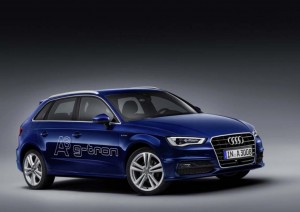Imagine capturing the gases spewing out of your car’s tailpipe and feeding them back into its engine. In a sense, that’s what Audi hopes to do with the new A3 g-Tron.
The German maker is the latest among a small but growing list of manufacturers introducing vehicles that can run on CNG, a fuel generally hailed as more environmentally friendly than conventional gasoline. But what’s particularly significant about the launch of the A3 g-Tron is how Audi wants buyers to fill up their tanks.
Working with Germany’s largest utility EWE, the luxury marque has tapped into a low-cost source of excess power from the wind farms spreading out over the northern corner of that country. In a complex process, a pilot refinery Audi has funded splits water into its fundamental components and then combines the hydrogen with CO2 to create a synthetic version of natural gas.
It will offer as many as 1,500 g-Tron buyers special contracts for this so-called e-Gas, enough for them to each drive about 15,000 kilometers, of about 9,500 miles, annually — each producing a fraction of the CO2 emissions of a regular automobile.
“We see this as a big solution,” says Reiner Mangold, Audi’s head of sustainable development. And, at a time when there is growing pressure to mandate a switch from conventional fossil fuels to electric propulsion, this unusual approach “means you can have a future for the combustion engine.”
Even with the A3 g-Tron set to go on sale in Europe late in 2013, Audi officials acknowledge they are still working on the details of their program. They have not finalized the price for the e-Gas contracts – though they also note that A3 g-Tron buyers will not be required to buy one of the agreements, anyway.
The Volkswagen luxury subsidiary also has to negotiate with European clean air regulators to get them to acknowledge the benefits claimed for the new car and the synthetic fuel it can use.
Proponents see several reasons to press for the expanded use of compressed natural gas. CNG is proving to be widely available, especially in places like the U.S. where vast underground stores are being tapped by new drilling methods, such as so-called “fracking.” And CNG produces about 20% lower CO2 emissions than gasoline when driven over the same distance.
That’s especially important in Europe, where the focus is on curbing CO2 output rather than on boosting miles per gallon, as in the United States. The EU has been steadily reducing its carbon dioxide target and now is aiming for a strict 95 gram per kilometer mandate, something that would actually translate into even better mileage than the 54.5 mpg Corporate Average Fuel Economy standard set to go into effect in the States in 2025.
CNG could get there more easily than gasoline. But e-Gas, contends Mangold, would emit barely a third as much CO2 as regular natural gas. Well, sort of. The synthetic gas is chemically identical to what comes out of the ground, but it essentially recycles carbon dioxide that would already be in the atmosphere.
The pilot refinery can either pull the global warming gas from the air we breathe or capture it from the exhaust, say, of a coal-fired generator, a chemical factory or a cement plant. So, if you factor that in, Audi estimates you’re only adding about 30 grams of “new” CO2 per kilometer driven by the A3 g-Tron. They just need to get regulators to acknowledge that.
By operating the refinery at night and weekends, when the regional demand for electricity is low, Audi expects to get a discount from the EWE utility. And that will keep e-Gas at about half the price of what a motorist would spend tanking up on gasoline in Germany – though the synthetic fuel would still be more expensive than regular CNG.
Customers who opt for an e-Gas contract for their new A3 g-Trons won’t necessarily fill up with the synthetic fuel. Audi simply will pump a comparable amount of the gas into the pipelines that serve Germany, displacing natural gas that would otherwise have to be pumped up from underground.
The country currently has one of the widest networks of CNG pumps available to the public anywhere in the world, with about 1,000 filling stations. The goal is to boost that by 50% — and to encourage neighboring countries, such as Italy and France, to make natural gas more widely available, as well.
Meanwhile, notes Mangold, consumers could also fill up at home, if they use natural gas for heating. Home compressors have been available for a number of years, and though they have been slow and expensive, new systems reaching market reportedly could cut the price to around $500 while slashing the time needed to fuel up.
That could significantly improve acceptance of CNG vehicles in the U.S., the Audi executive believes – though the maker currently has no plans to market the g-Tron in the States.
But other makers, including Honda and General Motors are expanding CNG vehicle availability here. And a new study by ExxonMobil suggests that the use of natural gas could quadruple in the coming years worldwide as a transportation fuel.


We’ll see how this synthetic CNG works out down the road a few years but CNG and propane have grown in popularity in recent years in Germany due to the outrageous prices the oil industry Cabal is charging because they have a monopoly.